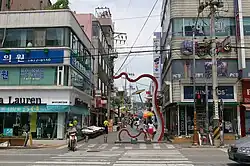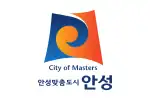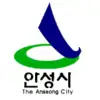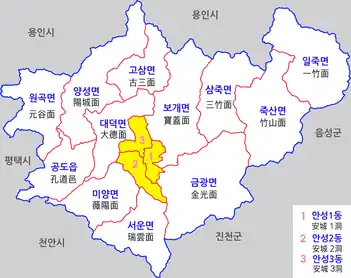Anseong
안성시 | |
|---|---|
| Korean transcription(s) | |
| • Hangul | 안성시 |
| • Hanja | 安城市 |
| • Revised Romanization | Anseong-si |
| • McCune-Reischauer | Ansŏng-si |
 Downtown Anseong | |
 Flag  Emblem of Anseong | |
| Country | |
| Region | Gyeonggi Province (Sudogwon) |
| Administrative divisions | 1 eup, 11 myeon, 3 dong |
| Government | |
| • Mayor | Kim Bo-ra (Democratic) |
| Area | |
| • Total | 554.2 km2 (214.0 sq mi) |
| Population (July 13, 2013) | |
| • Total | 190,095 |
| • Density | 340/km2 (890/sq mi) |
| • Dialect | Gyeonggi |
Anseong (Korean pronunciation: [an.sʌŋ]) is a city in Gyeonggi Province, South Korea, 80 kilometres (50 mi) south of Seoul. Its geographical location is 37°0′N 127°16′E / 37.000°N 127.267°E.
Anseong promotes itself as "The City of Masters". It is known for producing brassware and arts and crafts. From late spring to fall, Anseong holds its own Namsadang Neuri Festival. The agriculture of Anseong is centered around Asian pears, grapes, ginseng, and rice.
Modern history
In 1963, Gosam town of Yongin was incorporated by Anseong, which was still a county at the time.[1] In 1983, Anseong itself ceded 6 jurisdictions which were attached as a district of Pyeongtaek.[2] In 1998, Anseong was upgraded from county to city status.
It borders Pyeongtaek-si to the west, Yongin-si to the north, Icheon-si and Eumseong-gun to the east, and Cheonan-si, Chungcheongnam-do and Jincheon-gun, Chungcheongbuk-do to the south. It is located in the southernmost part of Gyeonggi-do and is adjacent to Chungcheong-do along with Pyeongtaek-si, so it serves as a gateway to the rest of the country. For this reason, in the past, it was counted as one of three major commercial centers in Korea with Daegu and Jeonju. At that time, Anseong was a bustling city. In particular, the 5-day market held on the 2nd and 7th of every month was one of the three largest markets in Joseon.
Population
- Anseong-si, Gyeonggi-do population trend &key developments (1966~present)
- 1966: 144,274
- 1970: 133,404
- 1975: 132,888
- 1980: 127,891
- 1983: Yong-ri, Jukbaek-ri, Cheongyong-ri, Wolgok-ri, Wongok-myeon, Sosa-ri, Gongdo-myeon were transferred to Pyeongtaek-eup, Pyeongtaek-gun.
- 1985: 121,752
- 1990: 118,260
- 1995: 124,671
- 1998: Anseong was upgraded from county to city status.
- 2000: 136,590
- 2005: 157,130
- 2010: 177,937
- 2015: 180,199
- 2020: 187,012
- September 2022: 189,648
The populations given are based on the administrative districts at the time, not the current administrative district.
1966-1990: National Statistical Office Census, 1995-Present: Resident Registration Population Statistics of Ministry of Public Administration and Security
Education
Institutions of higher learning in Anseong include:
- Ansung Women's Polytechnic College
- Capital Baptist Theological Seminary
- Chung-Ang University (Anseong campus)
- Dong-Ah Broadcasting College
- Doowon Technical College
- Hankyong National University
Hangyeore Middle and High School, a special school for North Korean refugees, is in Anseong.[3]
Geography
Land area by type and usage:

Climate
Anseong has a humid continental climate (Köppen: Dwa), but can be considered a borderline humid subtropical climate (Köppen: Cwa) using the −3 °C (27 °F) isotherm.
| Climate data for Anseong (1993–2020 normals) | |||||||||||||
|---|---|---|---|---|---|---|---|---|---|---|---|---|---|
| Month | Jan | Feb | Mar | Apr | May | Jun | Jul | Aug | Sep | Oct | Nov | Dec | Year |
| Mean daily maximum °C (°F) | 2.8 (37.0) |
5.8 (42.4) |
12.2 (54.0) |
19.0 (66.2) |
24.6 (76.3) |
28.3 (82.9) |
30.2 (86.4) |
31.0 (87.8) |
26.7 (80.1) |
20.8 (69.4) |
12.7 (54.9) |
4.7 (40.5) |
18.2 (64.8) |
| Daily mean °C (°F) | −2.4 (27.7) |
0.2 (32.4) |
5.6 (42.1) |
12.2 (54.0) |
18.1 (64.6) |
22.7 (72.9) |
25.6 (78.1) |
26.1 (79.0) |
21.2 (70.2) |
14.3 (57.7) |
6.9 (44.4) |
−0.4 (31.3) |
12.5 (54.5) |
| Mean daily minimum °C (°F) | −7.3 (18.9) |
−4.8 (23.4) |
−0.2 (31.6) |
5.9 (42.6) |
12.2 (54.0) |
17.9 (64.2) |
22.1 (71.8) |
22.5 (72.5) |
16.8 (62.2) |
8.8 (47.8) |
1.7 (35.1) |
−5.1 (22.8) |
7.5 (45.5) |
| Average precipitation mm (inches) | 19.0 (0.75) |
23.3 (0.92) |
34.9 (1.37) |
68.5 (2.70) |
72.6 (2.86) |
125.3 (4.93) |
323.1 (12.72) |
267.0 (10.51) |
149.1 (5.87) |
50.7 (2.00) |
41.4 (1.63) |
20.0 (0.79) |
1,194.9 (47.04) |
| Average precipitation days (≥ 0.1 mm) | 4.5 | 3.7 | 5.8 | 7.0 | 6.6 | 7.2 | 12.8 | 11.6 | 7.6 | 5.1 | 6.8 | 5.1 | 83.8 |
| Source: Korea Meteorological Administration[4] | |||||||||||||
Administrative districts

The city is divided into one eup (town) and 11 myeon (townships) and three dong (neighborhoods):
| Name | Hangul | Hanja | Population[5] | Households | Area (km2)[6] |
|---|---|---|---|---|---|
| Gongdo-eup | 공도읍 | 孔道邑 | 57,948 | 21,161 | 31.96 |
| Bogae-myeon | 보개면 | 寶蓋面 | 6,574 | 2,606 | 53.01 |
| Geumgwang-myeon | 금광면 | 金光面 | 8,755 | 3,515 | 71.71 |
| Seoun-myeon | 서운면 | 瑞雲面 | 4,479 | 1,739 | 36.28 |
| Miyang-myeon | 미양면 | 薇陽面 | 8,167 | 3,033 | 33.73 |
| Daedeok-myeon | 대덕면 | 大德面 | 12,606 | 6,362 | 31.16 |
| Yangseong-myeon | 양성면 | 陽城面 | 6,137 | 2,506 | 53.17 |
| Wongok-myeon | 원곡면 | 元谷面 | 5,607 | 2,253 | 37.83 |
| Gosam-myeon | 고삼면 | 古三面 | 2,163 | 918 | 27.79 |
| Iljuk-myeon | 일죽면 | 一竹面 | 9,229 | 3,669 | 55.54 |
| Juksan-myeon | 죽산면 | 竹山面 | 7,842 | 3,400 | 57.26 |
| Samjuk-myeon | 삼죽면 | 三竹面 | 4,113 | 1,688 | 39.07 |
| Anseong1-dong | 안성1동 | 安城1洞 | 13,444 | 5,306 | 6.55 |
| Anseong2-dong | 안성2동 | 安城2洞 | 19,460 | 7,322 | 10.14 |
| Anseong3-dong | 안성3동 | 安城3洞 | 23,571 | 8,136 | 8.27 |
Sister Cities
 Jongno District, Seoul
Jongno District, Seoul Brea, California, United States
Brea, California, United States
Notable people from Anseong
- Hong Sa-ik, Zainichi Korean war criminal and lieutenant general of the Imperial Japanese Army
- Pak Tu-jin, South Korean poet
- Cho Byung-hwa, South Korean poet, critic and essayist
- Kim Soo-ro, South Korean actor
- Andrew Yeom Soo-jung, South Korean cardinal of the Catholic Church and the Korean Roman Catholic Archbishop of Seoul
Gallery
 Statue of Namsadang Neuri
Statue of Namsadang Neuri Chung-ang Market
Chung-ang Market Rice fields
Rice fields
See also
References
- ↑ Alteration of cities/counties/districts(1962-11-21)
- ↑ Laws concerning change of districts of city, county, district, town, township and Establishment of new towns(1983-1-10)
- ↑ "N. Koreans have access to S. Korean media: survey." Korea Herald. June 14, 2010. Retrieved on May 15, 2013.
- ↑ "Climatological Normals of Korea (1991 ~ 2020)" (PDF) (in Korean). Korea Meteorological Administration. Archived from the original (PDF) on 29 January 2022. Retrieved 7 June 2023.
- ↑ "주민등록인구 - 안성시청" (in Korean). Archived from the original on 2015-09-23. Retrieved 2023-08-27.
- ↑ "행정구역 - 안성시청". Archived from the original on 2013-12-06. Retrieved 2013-09-05.
External links
- City government website (in English)
